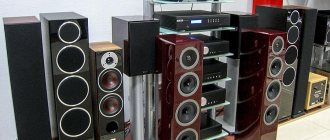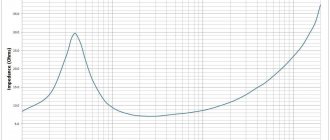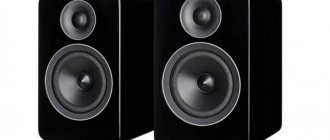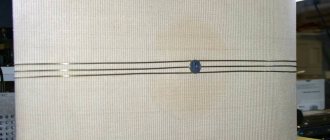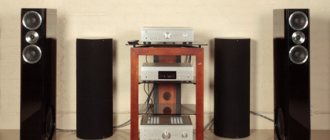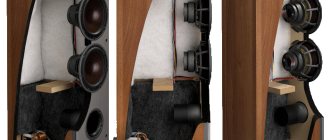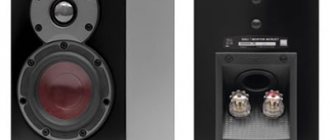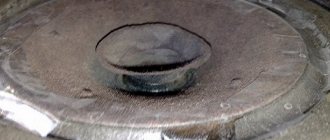Phase shift
- the difference between the initial phases of two variable quantities that change periodically over time with the same frequency.
The phase shift is a dimensionless quantity and can be measured in radians (degrees) or fractions of a period. With a constant, in particular zero, phase shift, the two processes are said to be coherent
. The phase (phase angle) is the angle φ = 2 π t T , {\displaystyle \varphi =2\pi {\frac {t}{T}},} where T {\displaystyle T} is the period, t {\displaystyle t } — fraction of the phase shift period when sinusoids are superimposed on each other. So if the curves (variable quantities - sinusoids: oscillations, currents) are shifted relative to each other by a quarter of a period, then we say that they are shifted in phase by π 2 ( 90 ∘ ) , {\displaystyle {\frac {\pi }{2}}~(90^{\circ }),} if by an eighth part (fraction) of a period, then it means by π 4 {\displaystyle {\frac {\pi }{4}}}, etc. d.[1] When talking about several sinusoids out of phase, technicians talk about current or voltage vectors. The length of the vector corresponds to the amplitude of the sinusoid, and the angle between the vectors corresponds to the phase shift. Many technical devices give us not a simple sinusoidal current, but one whose curve is the sum of several sinusoids (respectively, shifted in phase).
To measure the phase shift between two electrical signals, an electrical measuring device is used - a phase meter.
A phase detector is a device that compares the phases of two input signals and generates a signal proportional to the difference in their phases.
In electrical engineering, the phase shift between voltage and current determines the power factor in AC circuits.
In radio engineering, RC circuits are widely used, which shift the phase of the input and output signal of the RC circuit depending on the resistance and capacitance parameters in the circuit. Used in RC generators.
The EMF induced in the secondary windings of an ideal transformer for any current shape coincides in phase and shape with the EMF in the primary winding. When the windings are turned on in antiphase, the transformer changes the polarity of the instantaneous voltage to the opposite; in the case of sinusoidal voltage, it shifts the phase by 180°. Used in the Meissner generator, etc.
Phase, antiphase and phase shift
In this article we will consider such an important issue as the phase of the audio signal.
When you mention the section of school physics about harmonic oscillations, the first thing that comes to mind is that the phase is an argument of a periodic function that determines the amplitude of the signal at a certain point in time. What does this do for us musically? And where can problems arise with this very phase?
Imagine that we are recording a guitar. The sound is collected from the combo amplifier using two microphones. The signal from them is mixed and then goes into one channel. It is the summation of two signals that can lead to phase problems.
Signals in phase
An ideal repetition of signals is observed, in which the “peaks and troughs” of their amplitudes are absolutely synchronous in time. In this case, the signals are said to be “in phase”. In practice, this means that the signals will amplify each other. And ideally, the amplitude of the resulting signal will be equal to the sum of the amplitudes of each signal.
This arrangement not only does not threaten us with anything, but on the contrary, it is very desirable and useful in most cases.
Signals out of phase
It is noticeable on the oscilloscope that the “peak” of the first signal coincides with the “valley” of the second. From this it is easy to conclude that the addition of such oscillations will ideally result in absolute zero or, in other words, mutual suppression of both signals.
This arrangement will not bring anything good, so it should be avoided at all costs.
Phase shift
Phase shift implies a time delay of the first signal relative to the second.
With two harmonic oscillations of the same frequency, the result of a phase shift will be a partial attenuation of the signal. The degree of attenuation of the resulting signal will depend precisely on this very phase shift. In the limiting case, the output will be absolute zero. All these illustrations only vaguely relate to practical realities. The sound of a musical instrument is by no means a single-frequency signal. The sound of a guitar or any other instrument is characterized by a fairly large number of overtones.
Therefore, partial phase shift can lead to a greater attenuation of some frequencies compared to others, and even to an increase in some of them. One can easily guess that all this is affected by the phase shift between specific harmonics. By the way, it is precisely this principle of enhancing some frequencies and weakening others that underlies the well-known effect - the phaser. The circuit includes frequency filters, feedback circuits and mixing of the processed and unprocessed signal, but the main principle is precisely the phase shift. In general, the phase factor can cause many troubles. It's good if only two microphones are used when recording. In this case, you can experiment with the distance from the sound source to the microphones in order to select positions at which the signals from them arrive in phase. But the situation using, for example, ten microphones is much more complicated. By the way, many microphone preamplifiers are equipped with a signal polarity switch. The only thing is that the coincidence or mismatch of the “peaks” and “valleys” of both signals will be determined not by the difference in their phases, but by their polarity. But since the effect is the same, inverting the signals can be used to solve phase problems, which may or may not bring the desired result. The problem can also be solved by correcting the phase of an already recorded signal in any audio recording program, especially since modern digital audio processing provides limitless possibilities in this matter. You can notice the phase mismatch of signals by hearing by the characteristic loss of sound brightness, its “depletion”. If you hear any sound problems that are identical to those listed above, experiment with the phase. Phase problems can occur not only during microphone recording. For example, they can occur when you include a phaser in a parallel insert on a amp, since the phaser itself leads to a phase shift of the original signal and its further mixing with the dry signal. In addition, do not forget about the parallel loop. The result is predictably bad sound.
_____________________
Author: Irina Kiparenko
When copying material, a reference to the site is obligatory!
Like
SocButtons v1.5
| < Previous | Next > |
Mathematical definition[edit]
Let be a periodic signal (that is, a function of one real variable), and let be its period (that is, the smallest positive real number such that for all ). Then the phase
for
any argument is equal to F {\displaystyle F} T {\displaystyle T} F ( t + T ) = F ( t ) {\displaystyle F(t+T)=F(t)} t {\displaystyle t} F {\displaystyle F} t {\displaystyle t}
ϕ ( t ) = 2 π [ [ t − t 0 T ] ] {\displaystyle \phi (t)=2\pi \left[\!\!\left[ {\frac {t-t_{0}}{T}}\right]\!\!\right]}
Here denotes the fractional part of a real number, discarding its integer part; that is ,; and is an arbitrary "initial" value of the argument, which is considered the beginning of the loop. [ [ ⋅ ] ] {\displaystyle [\![\,\cdot \,]\!]\!\,} [ [ x ] ] = x − ⌊ x ⌋ {\displaystyle [\![x]\!] =x-\left\lfloor x\right\rfloor \!\,} t 0 {\displaystyle t_{0}}
This concept can be visualized by imagining a clock with a hand that rotates at a constant speed, completes a full rotation every second, and points straight ahead in time. Phase is the angle from the 12:00 position to the current position of the hand in time, measured clockwise. T {\displaystyle T} t 0 {\displaystyle t_{0}} ϕ ( t ) {\displaystyle \phi (t)} t {\displaystyle t}
The concept of phase is most useful when origins are selected based on characteristics. For example, for a sine wave, a convenient choice is any place where the value of the function changes from zero to positive. t 0 {\displaystyle t_{0}} F {\displaystyle F} t {\displaystyle t}
The above formula gives the phase as the angle in radians between 0 and . To get the phase as the angle between and , 2 π {\displaystyle 2\pi } − π {\displaystyle -\pi } + π {\displaystyle +\pi } is used instead
ϕ ( t ) = 2 π ( [ [ t − t 0 T + 1 2 ] ] − 1 2 ) {\displaystyle \phi (t)=2\pi \left(\left[\!\!\left[{ \frac {t-t_{0}}{T}}+{\frac {1}{2}}\right]\!\!\right]-{\frac {1}{2}}\right)}
Phase expressed in degrees (0° to 360° or -180° to +180°) is defined in the same way, except with "360°" instead of "2π".
Consequences[edit]
With any of the above definitions, the phase of a periodic signal is also periodic with the same period: ϕ ( t ) {\displaystyle \phi (t)} T {\displaystyle T}
ϕ ( t + T ) = ϕ ( t ) {\displaystyle \phi (t+T)=\phi (t)\quad \quad {}} for all . t {\displaystyle t}
At the beginning of each period the phase is zero; that is
ϕ ( t 0 + k T ) = 0 {\displaystyle \phi (t_{0}+kT)=0\quad \quad {}} for any integer. k {\displaystyle k}
Moreover, for any given choice of source, the value of the signal for any argument depends only on its phase at . Namely, we can write , where is an angle function defined for only one complete rotation, which describes the change as ranges over one period. t 0 {\displaystyle t_{0}} F {\displaystyle F} t {\displaystyle t} t {\displaystyle t} F ( t ) = f ( ϕ ( t ) ) {\displaystyle F(t)=f( \phi (t))} f {\displaystyle f} F {\displaystyle F} t {\displaystyle t}
In fact, every periodic signal with a specific waveform can be expressed as F {\displaystyle F}
F ( t ) = A w ( ϕ ( t ) ) {\displaystyle F(t)=A\,w(\phi (t))}
where is the “canonical” phase angle function in the range from 0 to 2π, which describes only one cycle of this waveform; and is the scaling factor for amplitude. (This statement assumes that the start time chosen for the phase calculation corresponds to the argument 0 of .) w {\displaystyle w} A {\displaystyle A} t 0 {\displaystyle t_{0}} F {\displaystyle F} w { \displaystyle w}
What is sound?
The textbook says: “The oscillatory movement of particles that propagates in the form of waves in gaseous, liquid or solid media.” Let's discard the unnecessary stuff and talk only about audible sound (besides it, there are also ultrasound, infrasound, etc.).
Sound is, in fact, not the movement of air (gas) in space, but wave, periodic changes in the pressure of this very gas. Sound is wave radiation, subject to the corresponding physical laws that describe its propagation and interactions. According to these laws, we can describe sound according to several characteristics. Let's take the basic ones: frequency, amplitude (oscillation shape) and speed.
Receiver circuit
In Fig. Figure 3 shows a diagram for receiving and converting an RF signal into digital form to accurately determine its amplitude and phase. The circuit contains a quadrature demodulator, a two-channel differential amplifier and a two-channel successive approximation ADC. The main purpose of the circuit is to accurately measure the amplitude and phase of a high-frequency input RF signal over a wide dynamic range.
Rice. 3. Simplified receiver circuit for materials analysis
How are sinusoids constructed?
Figure 3 shows how sinusoids are constructed. On the horizontal axis, either time is plotted, increasing from left to right, or the angles of rotation of the winding (magnet), which are counted from a certain position taken as the initial one. The values of e are plotted along the vertical axis. d.s., current or other periodic quantity, proportional to the sines of the rotation angles. Angles can be measured in degrees or radians. In Figure 3, time is given in fractions of a period: T/4, T/2, ¾ T, T; rotation angles are also shown: 0, 30, 60, 90, ..., 360°. It must be borne in mind that in bipolar generators the period corresponds to a full revolution, that is, it is completed through 360°, or 2π radians, that is, in order for one of the winding conductors, leaving under the north (south) pole, to return to it, it must rotate 360°. Therefore, in Figure 3, which is built for a two-pole generator, the period T corresponds to 360°, the half period T/2 to 180°, the quarter period T/4 to 90°, and so on.
Figure 3. Technique for constructing a sine wave
In multi-pole generators, the electrical and geometric degrees do not coincide, because the poles of the same name, for example the north ones, are located closer to each other: in a four-pole generator at a distance of 180°, in a six-pole generator - at a distance of 120°, and so on. And since, regardless of the number of poles, all generators produce current of the same industrial frequency, that is, they have the same periods, the generator rotors must make different paths in the same time: a revolution, half a revolution, a third of a revolution, and so on. Therefore, generator rotors have different rotation speeds, that is, they rotate at different rotation frequencies (speeds): the fastest are two-pole (3000 rpm), four-pole ones make 1500 rpm, six-pole ones 1000 rpm, and so on.
Let us note one extremely important circumstance: the sinusoid is a periodic curve, that is, it has neither end nor beginning, and therefore it is not at all necessary to draw it starting from 0°. You can equally well start with 30, 47, 122 (-60°) and so on
But since in these cases the countdown will start later or earlier, it needs to end the same amount later or earlier.
File archive ›› Star, triangle, zigzag. Kaminsky E.A. Electrician's Library
How to wind fishing line or cord on a reel: practical tips for beginners
This book describes the properties of star, triangle and zigzag connections. It is shown how to select the required type of connection and how to carry it out. Common mistakes are described and how to prevent them is explained. The 3rd edition takes into account the comments and wishes of readers, in particular, it talks about connecting into a six-phase star, zigzag, open and open and triangle. Electrician's Library. Issue 250, Issue 374
Star Triangle Properties of star and triangle Concept of magnetic balance of a transformer Zigzag Determination of device terminals Transformer connection groups Some errors in star, delta, zigzag connections Six-phase star and double zigzag Open delta. Open delta Connections of instrument transformers Artificial zero point Obtaining the required phase shift The concept of phasing
What is the frequency of sound?
Frequency is the number of vibrations per unit of time. More specifically, the number of vibrations per second. It is measured in Hertz. One oscillation per second is one hertz (Hz). If we also remember that sound travels in the air at a speed of about 350 meters per second or about 1250 km/h, then it is quite easy to understand that frequency and speed are related. And this connection gives us the opportunity to determine the length of the sound wave: the higher the frequency, the shorter the wavelength - and vice versa.
It is almost traditionally believed that human hearing can hear a frequency range of "20-20" - from 20 Hz to 20 kHz, in other words, from 20 vibrations per second to 20,000.
Not all frequencies are equally loud
At the same time, Mother Nature has endowed us with quite selective hearing. Psychoacoustic studies show that people hear best what is most important to them—human speech. These sounds are located in the frequency range around 3000 Hz. Somewhere in this area is the maximum sensitivity of our ears.
At other frequencies it decreases, changing in the form of smooth curves. These curves show how loud a person perceives sound vibrations of equal amplitude. This data is important not only for the calculation of acoustic systems, but also for a correct understanding of the nature of sound perception.
They were obtained statistically, when a large number of people took part in the subjective assessment of sound volume at different frequencies. In honor of the authors of this scientific development, lines of equal loudness are called Fletcher-Manson curves.
Links[edit]
- ^ ab Ballou, Glen (2005). Sound Engineer's Handbook (3rd ed.). Focal Press, Gulf Professional Publishing. item 1499. ISBN 978-0-240-80758-4.
- ^ abc Time and frequency from A to Z (2010-05-12). "Phase". National Institute of Standards and Technology (NIST). Retrieved June 12, 2016. This content was copied and pasted from the NIST webpage and is in the public domain
. - Clint Goss; Barry Higgins (2013). "Singer". Flutepedia
. Retrieved March 6, 2013.
External links [edit]
| Wikimedia Commons has media related to Phase (wave) . |
- “What is a phase? " Prof. Jeffrey Hass. " Textbook of Phonics
", Section 8. Indiana University. © 2003. See also: (pp. 1–3. © 2013) - Phase angle, phase difference, time delay and frequency
- ECE 209: Sources of Phase Shift - Discusses sources of time-domain phase shift in simple linear time-invariant circuits.
- Open Source Physics JavaScript HTML5
- Java applet for phase difference
